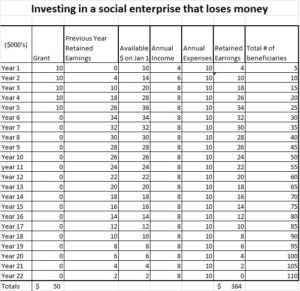Assume for a moment you are a funder or a philanthropist. You have money and you want it to be used to help people, build community or address a social, cultural or environmental challenge. Of course, you want to make a significant difference, but naturally, the amount you have is limited. (Let’s say $10K/year)
You’ve just received two applications for funding: Case A and Case B
Case A is a request by a reputable charitable organization for $50K. They need the money to help support an employment training program for people who have been in conflict with the law and are struggling to get back into the workforce. The training is for 10 people per year, and offers classroom learning, personal coaching, resume writing and even access to a job fair at the end of each year. They project that 5 out of 10 of their annual “graduates” will find work. The application is for five years of funding, and there is a promise in the application that by the end of five years, the organization will have found an alternative funder to continue to offer the program.
Case B is a $50k request by a social enterprise. The cause is the same—to employ people formerly in conflict with the law—except that the money will be used to run a social enterprise to hire and train 5 people per year. The application indicates that they expect to make $4k in revenue in year one from selling the thing-a-ma-jigs that they make. The skills required to work in the social enterprise are highly transferrable to other jobs in light manufacturing. In year two, they hope to make $6k, and in years 3, 4 and 5 they will make $8k per year. After the five years, they believe that they won’t quite make enough to keep the business running, as they will be about $2k short on the $10K a year budget they require. They are, in fact, planning a business that they don’t believe will ever break even.
Who will you fund? Where will you get the best social return on your investment?
Like any rational person, you weight the facts and the outcomes expected of the proposals. First, the similarities: Both Case A and B will help a marginalized population in need of assistance; both will help train and employ 25 people by the end of five years; both applicants are requesting the same amount of money; thus, the cost per beneficiary is expected to be $2K per newly-employed person in five years in both cases.
The difference is in the longevity of each of the methodologies. With apologies for the simplicity of this example, let’s look at the expected outcomes after five years:
Case A will fold unless another funder is found. After you’ve invested $10K/year for five years, you are (perhaps) willing to keep investing, but you know that will keep you from supporting other initiatives. If you don’t have the money or interest to continue supporting the program, there needs to be $10K per year donated by someone!
Case B has a different financial outcome, as represented below:
The question on which application to fund become crystal clear:
For Case A, you invest $50K, and 25 individuals get jobs. The beneficiaries get all support for free, but they have to make time to do the program without any financial compensation and their employment success is only realized at the end of the year. Moreover, the program has an uncertain future in year six.
For Case B, you invest $50K, and help 110 individuals over 22 years, even though the business was projected to earn only 80% of its necessary operating costs each year.
Case B has other benefits as well:
- The individuals are paid to learn, which means they benefit from the grant money and the business operations directly.
- The employment history and reference from the social enterprise is invaluable for future employment.
- Even if the business only hired five people to start and two new people each year, it would still create employment for 47 individuals over the lifetime of the business.
- If the business actually grew (ie more than 8K in revenue each year) and the focus on hiring more people remains integral to the social mission, even if the costs increased commensurately, the social benefit would grow impressively out of your $50K investment.
- If you wanted to keep the business running indefinitely, it would require only $2K a year in support. ( and only in year 23, by the way)
Social Enterprises don’t need to be profitable to be beneficial. In fact, an investment in any social organization that seeks to generate a financial return while fulfilling their social mission will stretch the investment dollar. Of course, financial sustainability should be a goal, but even a money-losing social enterprise is working to change the landscape in a powerful way.
Jonathan Wade has been a consultant in social enterprise for more than 8 years, based out of Ottawa. For other blog posts and for information on his consulting services, visit www.socialdelta.ca




This is such a flawed example – no business has flat expenses for 22 years, particularly social enterprises who almost always use a lot of sweat equity to get off the ground. The idea that cost-per-participant never escalates is a false one.
In years 3-4, when your employees start wanting say, benefits, pensions, training, overtime, etc. to compensate for the “start-up” years, costs almost always escalate. The expense model you’ve used here does not hold for any start-ups. The social enterprise could raise its costs/fees to compensate, but most social enterprises don’t because it then calls into question how “social” they are if they start pricing out their clients.
There is also the case of retained earnings – in this case, a granter put $50k into a social enterprise that now has $34k in retained earnings. There is nothing legally preventing that enterprise from liquidating its reserve cash in year 6 – or selling the business, as has been documented in numerous cases previously.
There are more likely ends for a social enterprise losing money other than a perpetual fixed-cost model. This is born out by the high failure rates in countries who actually track this stuff.